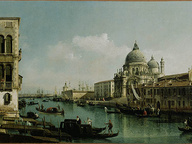Atelier Bevilacqua La Masa 2014. Mostra di fine residenza

Atelier Bevilacqua La Masa 2014. Mostra di fine residenza
From 22 January 2015 to 22 February 2015
Venice
Place: Fondazione Bevilacqua La Masa - Galleria di Piazza San Marco
Address: piazza San Marco 71/c
Responsibles: Rachele D’Osualdo
Ticket price: free entrance
Telefono per informazioni: +39 041 5207797
E-Mail info: info@bevilacqualamasa.it
Official site: http://www.bevilacqualamasa.it
Opens Thursday, January 22, 2015, in the Galleria di Piazza San Marco of the Fondazione Bevilacqua La Masa, the "Mostra di fine residenza" of artists assigned an Atelier at the Venetian Institution for the year 2014. In the exhibition, curated by Rachel D'Osualdo , will exhibit the works of Giuseppe Abate and Paola Angelini, Anemoi, Marko Bjelan?evi?, Saverio Bonato, Pamela Breda, Samuele Cherubini, gli Impresari, Graziano Meneghin e Jacopo Trabona, Fabrizio Perghem, Fabio Roncato, Caterina Erica Shanta, Eleonora Sovrani.
Giving continuity to one of the oldest programs of residences for artists in Europe, every year the Bevilacqua La Masa assigns, through a competition twelve studio located in the historic center of Venice, at Palazzo Carminati in San Stae and the Complex of SS. Cosma and Damiano on the Giudecca, to as many emerging artists who have chosen to live and operate in the Triveneto, immersing them in an environment of constant creative experimentation and mutual comparison. To them is dedicated a rich program of initiatives such as visits to the studies by the industry, public meetings, exhibition opportunities often in collaboration with important cultural institutions, city and national, partners and supporters. Gallery of Piazza San Marco will exhibit the works that artists have produced in the studios, addressing topics as diverse as the different artistic practices through which they are expressed.
During the inauguration, the collective will present Anemoi performing Rhapsody Venetian: a composition for choir processed using phrases heard and gathered in the street, in the various districts of the city. A project ironic, who wants to amplify in a composition singing a "choral" already present in our daily lives, the multitude of voices that reflect the sense of loss of our time.
Originates from the relationship with the audience the project Bjelan?evi? Marko, whose research is dedicated to the investigation on the identity and personal data that consciously or not each of us is left to "steal", through photographs, digital tools and the different devices we observe in everyday life.
The draft Saverio Bonato leads us to reflect, with a sensitivity away from the noise that accompanies the news media, the problems of environmental pollution caused by Ilva of Taranto that have caused and continue to cause hospitalizations and respiratory deaths and cancer. The artist has exhibited the Monochrome Tarantini, a series of canvases which placed the territory of Taranto, allowing the deposition on them of iron powders that become pigment. For they are accompanied by a publication in which they are collected or written by journalists, curators, researchers and citizens, next to the photographic documentation of the work.
With the installation of Samuel Cherubini, called peristalsis, the visitor is confronted with the complex "digestion" by the artist, the different artistic projects unfinished who accompanied him during the year of residence. Approaching the gelatinous matter, with physical contact, and predisposing to listening, the audience can understand the artist's reflections on the creation, display and the evolution of his work, coming to discover the most intimate and emotional.
Impresarios enact the Commedia dell'Arte Contemporanea: favoring the idea of controlled improvisation typical of the Commedia dell'Arte, during the opening ceremony, a performance show the public the work behind the scenes of the artisans who were studying the mechanisms of two stage effects, the machine of the clouds and the waves. Complete the project a second round, to be held January 23 in the Palladian Refectory at the Fondazione Cini in Venice. Here, professional actors and stage machinery will present portions of The Comedy of machinery, a piece written by the artist Gian Lorenzo Bernini that the collective will entirely staged in September of 2015.
On the first floor, the duo of painters Joseph Abate and Paola Angelini presents a project for four hands, where the language of painting becomes a medium of exchange and mutual interaction. The area of confrontation is the study from life of a masterpiece of Venetian painting, the Pietà by Titian, at the Gallerie dell'Accademia in Venice, thanks to a collaboration with the Superintendence for the historical, artistic and ethno-anthropological and the Polo museums of Venice and the municipalities of Eaves lagoon. If Paola Angelini showcases the studies thus produced, with a serial approach that allows a continuous reworking of the subject until you get to the abstraction of the same, the classical subjects are combined with imaginary ironic and contemporary, as in the design of Joseph Abate, along ten yards: a "wallpaper" from appearance that reveals a playful and irreverent satirical representation of the boy Scouts.
Eleonora Sovereigns imagines a scenario catastrophic, yet plausible: the explosion of image database search engine world. The work thus places the viewer in front of some questions: What would happen to the virtual images lost? How to preserve the memory? And as the daily action imprinted on the users of the web, over the years, it has now shaped the imagination?
E 'to the land, to its formation and transformation that looks artistic research Fabio Roncato. Buried in the work Horizons artist brings to light the Caranto, a layer of clay compact territory, once surface and buried now, present in the lagoon and on which the city of Venice. The artist digs the lagoon area reporting in this area and geological horizon projecting layer showed an astronomical observation: the light generated by a star simultaneously with the formation of the rock.
The draft Fabrizio Perghem aspires to the description of a form without the visual image: the artist asks in fact to some interpreters to resort all'ecolocalizzazione, mechanism used by different animals, making sounds in the environment, we hear the echoes bounce from different objects, thus reaching identify the latter, their fattezza and their distance. The artist also questions about how it can be reported and remembered this form and experience of its mental representation, after removing the visual component.
What 'here's', you can' find elsewhere; but what 'here is not found, there is no place in an installation environment is conceived by Graziano Meneghin and Jacopo Trabona, which are documented in six exhibitions that, in a fictional way, have taken place in their studio in Palazzo Carminati. The visitor is thus to learn, through conventional media and codified in the art world as the video, poster, press release, a series of narratives whose protagonists are artists who have lived virtually the studio and who embody each one specific stylistic artistic contemporary language.
The exhibition ends with a space film, where the two videos projected indicate to the viewer two different artistic approaches in the use of archival materials.
Walden, Pamela Breda, arises from the assembly of documentary films made by American director Johanna Alemann between the fifties and sixties of the last century. The movies were dismantled and reconstructed in the chromatic scale, depending on the prevailing color in each frame. The images are accompanied with extracts from "Walden, or Life in the Woods", a book written by the philosopher Henry David Thoreau in 1854, a reflection on his experiences of living in close contact with nature, that he undertook to get away from the contemporary urban society . The project reflects the idealized relationship that we have with nature and the filter of the cinematic image, which proposes a reconstruction fictitious natural scope.
The video documentary by Catherine Erica Shanta, entitled Dreams, through photographs, books, magazines, collected in various archives of the city, flanked by a series of interviews, reconstructs the Venice of the period of World War II. By rationing food to building bunkers against air raids that never took place, by the images of propaganda to the transfer of Cinecittà film studios from the gardens of the Biennale: what emerges is a tale of a city, so painstakingly rebuilt as personal reflection on the ambiguity beauty.
On the occasion of the exhibition of fine residence will be presented to the public the volume It's a very nice day, a new publishing project published by Moleskine and Bevilacqua La Masa entirely dedicated to the city of Venice. The publication collects fact original contributions of the artists workshops Bevilacqua La Masa in 2014, whose projects return a portrait of the city and unusual faceted, ranging from its historical roots to the peculiar environmental conditions, natural or caused by its industrial lived; reflections born from the analysis of the imaginary product on Venice alternate projects that capture the daily experience of the city, in its different sensory dimensions.
Special thanks to Moleskine, supporting partner of the program of studies of the artist since 2008, and Stonefly, which supported the Atelier for the fifth consecutive year.
The Commedia dell'Arte Contemporanea is a project in collaboration with:
Giorgio Cini Foundation Onlus, Study Centre for Documentary Research into European Theatre and Opera, Bonotto Foundation, Theatre Company BluTeatro, wala Lab Workshop Gistö, Feltrinlegno, SaLE Docks and Rebiennale.
Giving continuity to one of the oldest programs of residences for artists in Europe, every year the Bevilacqua La Masa assigns, through a competition twelve studio located in the historic center of Venice, at Palazzo Carminati in San Stae and the Complex of SS. Cosma and Damiano on the Giudecca, to as many emerging artists who have chosen to live and operate in the Triveneto, immersing them in an environment of constant creative experimentation and mutual comparison. To them is dedicated a rich program of initiatives such as visits to the studies by the industry, public meetings, exhibition opportunities often in collaboration with important cultural institutions, city and national, partners and supporters. Gallery of Piazza San Marco will exhibit the works that artists have produced in the studios, addressing topics as diverse as the different artistic practices through which they are expressed.
During the inauguration, the collective will present Anemoi performing Rhapsody Venetian: a composition for choir processed using phrases heard and gathered in the street, in the various districts of the city. A project ironic, who wants to amplify in a composition singing a "choral" already present in our daily lives, the multitude of voices that reflect the sense of loss of our time.
Originates from the relationship with the audience the project Bjelan?evi? Marko, whose research is dedicated to the investigation on the identity and personal data that consciously or not each of us is left to "steal", through photographs, digital tools and the different devices we observe in everyday life.
The draft Saverio Bonato leads us to reflect, with a sensitivity away from the noise that accompanies the news media, the problems of environmental pollution caused by Ilva of Taranto that have caused and continue to cause hospitalizations and respiratory deaths and cancer. The artist has exhibited the Monochrome Tarantini, a series of canvases which placed the territory of Taranto, allowing the deposition on them of iron powders that become pigment. For they are accompanied by a publication in which they are collected or written by journalists, curators, researchers and citizens, next to the photographic documentation of the work.
With the installation of Samuel Cherubini, called peristalsis, the visitor is confronted with the complex "digestion" by the artist, the different artistic projects unfinished who accompanied him during the year of residence. Approaching the gelatinous matter, with physical contact, and predisposing to listening, the audience can understand the artist's reflections on the creation, display and the evolution of his work, coming to discover the most intimate and emotional.
Impresarios enact the Commedia dell'Arte Contemporanea: favoring the idea of controlled improvisation typical of the Commedia dell'Arte, during the opening ceremony, a performance show the public the work behind the scenes of the artisans who were studying the mechanisms of two stage effects, the machine of the clouds and the waves. Complete the project a second round, to be held January 23 in the Palladian Refectory at the Fondazione Cini in Venice. Here, professional actors and stage machinery will present portions of The Comedy of machinery, a piece written by the artist Gian Lorenzo Bernini that the collective will entirely staged in September of 2015.
On the first floor, the duo of painters Joseph Abate and Paola Angelini presents a project for four hands, where the language of painting becomes a medium of exchange and mutual interaction. The area of confrontation is the study from life of a masterpiece of Venetian painting, the Pietà by Titian, at the Gallerie dell'Accademia in Venice, thanks to a collaboration with the Superintendence for the historical, artistic and ethno-anthropological and the Polo museums of Venice and the municipalities of Eaves lagoon. If Paola Angelini showcases the studies thus produced, with a serial approach that allows a continuous reworking of the subject until you get to the abstraction of the same, the classical subjects are combined with imaginary ironic and contemporary, as in the design of Joseph Abate, along ten yards: a "wallpaper" from appearance that reveals a playful and irreverent satirical representation of the boy Scouts.
Eleonora Sovereigns imagines a scenario catastrophic, yet plausible: the explosion of image database search engine world. The work thus places the viewer in front of some questions: What would happen to the virtual images lost? How to preserve the memory? And as the daily action imprinted on the users of the web, over the years, it has now shaped the imagination?
E 'to the land, to its formation and transformation that looks artistic research Fabio Roncato. Buried in the work Horizons artist brings to light the Caranto, a layer of clay compact territory, once surface and buried now, present in the lagoon and on which the city of Venice. The artist digs the lagoon area reporting in this area and geological horizon projecting layer showed an astronomical observation: the light generated by a star simultaneously with the formation of the rock.
The draft Fabrizio Perghem aspires to the description of a form without the visual image: the artist asks in fact to some interpreters to resort all'ecolocalizzazione, mechanism used by different animals, making sounds in the environment, we hear the echoes bounce from different objects, thus reaching identify the latter, their fattezza and their distance. The artist also questions about how it can be reported and remembered this form and experience of its mental representation, after removing the visual component.
What 'here's', you can' find elsewhere; but what 'here is not found, there is no place in an installation environment is conceived by Graziano Meneghin and Jacopo Trabona, which are documented in six exhibitions that, in a fictional way, have taken place in their studio in Palazzo Carminati. The visitor is thus to learn, through conventional media and codified in the art world as the video, poster, press release, a series of narratives whose protagonists are artists who have lived virtually the studio and who embody each one specific stylistic artistic contemporary language.
The exhibition ends with a space film, where the two videos projected indicate to the viewer two different artistic approaches in the use of archival materials.
Walden, Pamela Breda, arises from the assembly of documentary films made by American director Johanna Alemann between the fifties and sixties of the last century. The movies were dismantled and reconstructed in the chromatic scale, depending on the prevailing color in each frame. The images are accompanied with extracts from "Walden, or Life in the Woods", a book written by the philosopher Henry David Thoreau in 1854, a reflection on his experiences of living in close contact with nature, that he undertook to get away from the contemporary urban society . The project reflects the idealized relationship that we have with nature and the filter of the cinematic image, which proposes a reconstruction fictitious natural scope.
The video documentary by Catherine Erica Shanta, entitled Dreams, through photographs, books, magazines, collected in various archives of the city, flanked by a series of interviews, reconstructs the Venice of the period of World War II. By rationing food to building bunkers against air raids that never took place, by the images of propaganda to the transfer of Cinecittà film studios from the gardens of the Biennale: what emerges is a tale of a city, so painstakingly rebuilt as personal reflection on the ambiguity beauty.
On the occasion of the exhibition of fine residence will be presented to the public the volume It's a very nice day, a new publishing project published by Moleskine and Bevilacqua La Masa entirely dedicated to the city of Venice. The publication collects fact original contributions of the artists workshops Bevilacqua La Masa in 2014, whose projects return a portrait of the city and unusual faceted, ranging from its historical roots to the peculiar environmental conditions, natural or caused by its industrial lived; reflections born from the analysis of the imaginary product on Venice alternate projects that capture the daily experience of the city, in its different sensory dimensions.
Special thanks to Moleskine, supporting partner of the program of studies of the artist since 2008, and Stonefly, which supported the Atelier for the fifth consecutive year.
The Commedia dell'Arte Contemporanea is a project in collaboration with:
Giorgio Cini Foundation Onlus, Study Centre for Documentary Research into European Theatre and Opera, Bonotto Foundation, Theatre Company BluTeatro, wala Lab Workshop Gistö, Feltrinlegno, SaLE Docks and Rebiennale.
SCARICA IL COMUNICATO IN PDF
raffaele della rovere
·
eleonora sovrani
·
fabio roncato
·
pamela breda
·
anemoi
·
gli impresari
·
samuele cherubini
·
caterina erica shanta
·
saverio bonato
·
giuseppe abate e paola angelini
·
graziano meneghin e jacopo trabona
·
fabrizio perghem
·
COMMENTI

-
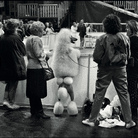 Dal 28 June 2025 al 21 September 2025
Roma | Palazzo Bonaparte
Dal 28 June 2025 al 21 September 2025
Roma | Palazzo Bonaparte
-
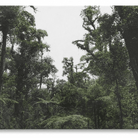 Dal 24 June 2025 al 29 October 2025
Firenze | Museo Novecento
Dal 24 June 2025 al 29 October 2025
Firenze | Museo Novecento
-
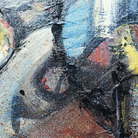 Dal 26 June 2025 al 18 July 2025
Firenze | Palazzo Sacrati Strozzi
Dal 26 June 2025 al 18 July 2025
Firenze | Palazzo Sacrati Strozzi
-
 Dal 26 June 2025 al 28 September 2025
Roma | Vittoriano - Sala Zanardelli
Dal 26 June 2025 al 28 September 2025
Roma | Vittoriano - Sala Zanardelli
-
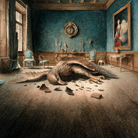 Dal 25 June 2025 al 26 October 2025
Bergamo | GAMeC
Dal 25 June 2025 al 26 October 2025
Bergamo | GAMeC
-
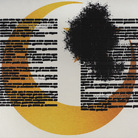 Dal 17 June 2025 al 6 January 2026
Perugia | Palazzo Baldeschi
Dal 17 June 2025 al 6 January 2026
Perugia | Palazzo Baldeschi

